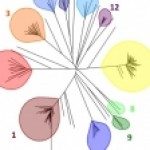Link to Pubmed [PMID] – 25875512
PLoS Genet. 2015 Apr;11(4):e1005152
Candida albicans is a major invasive fungal pathogen in humans. An important virulence factor is its ability to switch between the yeast and hyphal forms, and these filamentous forms are important in tissue penetration and invasion. A common feature for filamentous growth is the ability to inhibit cell separation after cytokinesis, although it is poorly understood how this process is regulated developmentally. In C. albicans, the formation of filaments during hyphal growth requires changes in septin ring dynamics. In this work, we studied the functional relationship between septins and the transcription factor Ace2, which controls the expression of enzymes that catalyze septum degradation. We found that alternative translation initiation produces two Ace2 isoforms. While full-length Ace2, Ace2L, influences septin dynamics in a transcription-independent manner in hyphal cells but not in yeast cells, the use of methionine-55 as the initiation codon gives rise to Ace2S, which functions as the nuclear transcription factor required for the expression of cell separation genes. Genetic evidence indicates that Ace2L influences the incorporation of the Sep7 septin to hyphal septin rings in order to avoid inappropriate activation of cell separation during filamentous growth. Interestingly, a natural single nucleotide polymorphism (SNP) present in the C. albicans WO-1 background and other C. albicans commensal and clinical isolates generates a stop codon in the ninth codon of Ace2L that mimics the phenotype of cells lacking Ace2L. Finally, we report that Ace2L and Ace2S interact with the NDR kinase Cbk1 and that impairing activity of this kinase results in a defect in septin dynamics similar to that of hyphal cells lacking Ace2L. Together, our findings identify Ace2L and the NDR kinase Cbk1 as new elements of the signaling system that modify septin ring dynamics in hyphae to allow cell-chain formation, a feature that appears to have evolved in specific C. albicans lineages.




